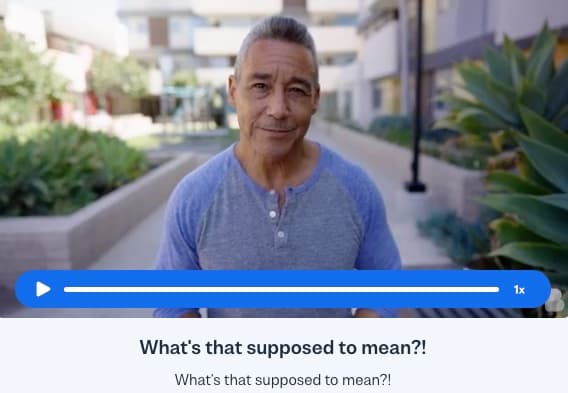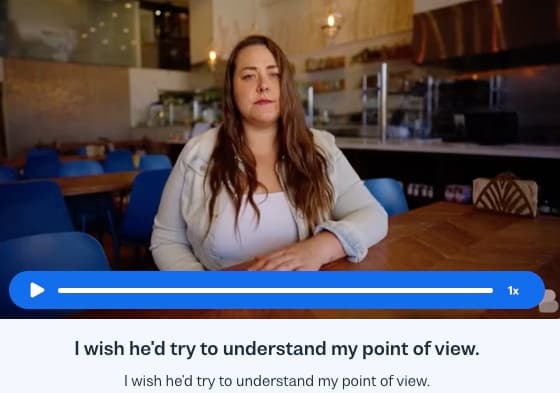I want to learn...
Emojis are a huge part of written, digital communication — they’re everywhere from texts, to emails, to social media (check out Busuu’s TikTok and see various emojis used!). The little digital pictures have had a big impact on digital communication in the last 20 years. They’re not only useful for texting your friends though. There are some ways you can use them in your language learning too.
In this article, you’ll learn all about emojis, how you can use them in language learning, and why they’re best combined with other language-learning methods.
Curious to know more about emojis?
Emojis are digital icons like the smiley (😀), which is used when you want to express joy, or the prayer gesture (🙏) which can also mean “thank you”. Busuu’s online courses and learning resources includes a lot of emojis that makes learning more fun and engaging! Check them out today!
What are emojis?
Emojis are digital icons people use in electronic, written communication to show emotions, ideas, or objects. Some of the most common are the smiley (😀) or sad (😞) faces you use when texting your friends. But, there are emojis for everything from aliens (👽) to animals (🦒), and wizards (🧙♂️) to hand gestures (🤝).
Emojis came from Japan in the late 1990s. The word “emoji” is a combination of the words for picture (絵, e) and character/letter (文字, moji) in Japanese. Emojis are an evolution of emoticons — punctuation marks that show emotions like :) — which people have been using since the 1980s.
Although emojis started as simple smiley faces and hearts, they have expanded to include symbols for emotions, activities, animals, people, and more. And they’re so common nowadays in online communication that in 2015, the Oxford Dictionary named the face with tears of joy emoji (😂) as its word of the year.
Can you learn a language with emojis?
Okay, we know how popular emojis are in online communication, but let’s get real — you’re not going to become fluent in a language because of emojis. On their own, they don’t help you learn anything. But there are some ways they can be useful when combined with other language learning methods.
4 ways you can use emojis in your language learning
Emojis are obviously effective for communication. And because learning a language is all about communicating, they can be useful for language learners too. Here’s how.
1. Visual vocabulary building
Associating words with images is an effective way to memorize them. Emojis are images. So you can use them to build your vocabulary. When learning new words, associate them with the relevant emoji. Emojis are great for helping you to remember emotions and tangible nouns. Here’s a couple of ways you can do this.
If you use digital flashcards, use emojis on the front and the word you want to remember on the back. For example, let’s say you're studying French. Put the French word for sad —“triste”— on the back of the card and the crying face emoji (😢) on the front. Try and remember the word just by looking at the emoji. To make flashcards extra effective, you should combine them with spaced repetition.
You can also use emojis in your vocabulary notebook (as long as it’s a digital one). Writing down the new words you come across can help you remember them. There’s a bunch of important information you need to include: Translation, pronunciation, part of speech, synonyms, antonyms, and example sentences. You can add emojis to the notes too to create an image association.
Here’s an example Japanese learner’s vocabulary notebook for the word “skeptical”:
Word: 疑問視
Translation: being skeptical
Pronunciation: ぎもんし, gimonshi
Part of speech: Noun
Synonyms: 疑わしい, 疑ぐり深い,
Antonyms: だまされやすい (gullible), 確固不動 (unshakeable belief)
Example sentences: 彼の能力を疑問視する人もいた。= Some people questioned his ability.
Emoji: 🤨
2. Language games
Emojis are fun to use in language games with friends. First, there’s the ‘emoji game’. Describe the emoji in your new language and your partner has to guess which emoji you’re talking about. Second, you can play ‘emoji pictionary’. This time you use emojis instead of words to make a sentence or phrase in your new language. Your partner has to guess correctly.
Language games are effective for a few reasons. They’re fun, of course, which is great for motivation. But also you need to engage with your new language.
3. Overcoming language barriers
It’s very common when trying to communicate in another language to get stuck, to forget words, or to not know the word in the first place. This isn’t a problem when you’re writing an essay or an email because you have time to use your dictionary. But if you’re chatting with a friend and the messages are flying around, maybe you don’t want to open up a different app to search for a word or phrase. You don’t want to interrupt the communication. So use an emoji.
Use them to fill the gaps in your sentences. Emojis are so common that your friends will understand what you’re trying to say. Sure, this won’t help you learn those words. But it will keep your communication smooth.
4. Expressing humor and tone
To be funny in another language you need to know the language — and its culture — well. This isn’t easy and takes time (especially in written communication). Emojis are an easy little shortcut you can use. You can use them to show your intentions which makes it easier for your readers to understand you. For example, when you want to be sarcastic or ironic, you could use the upside down face emoji (🙃). When you want to show you’re not being serious, you can add the winking face emoji (😉).
Why emojis shouldn’t be a big part of your language learning
You can use emojis to help you communicate in your new language. But the key word here is “help.” On their own, they’re pretty useless as a way to learn a language. Sure, they’re good for word lists and games. And they’re fantastic for filling in gaps in vocabulary knowledge when texting. But that’s about it. Your language learning should be a balance of proven methods. Emojis can’t replace reading, listening, grammar study, or meaningful practice. But they can help with digital communication.
Reasons not to rely on emojis when learning a new language
Here are some things you should be aware of when you use emojis in your new language:
Lack of depth
Emojis are simple, digital pictures. So of course it’s hard to use them to express complex concepts. They’re really useful for simple, every day, and casual phrases and communication. But anything more than that and they aren’t suitable.
Cultural differences
Emojis aren’t a universal language because people in different cultures view them differently. So using a word instead of an emoji is clearer and less likely to lead to cultural misunderstandings.
Let’s take a look at some differences in interpretation:
Folded Hands Emoji (🙏) means prayer (or even high five) in Western cultures. But in Japan, it means thank you. And in India, it means namaste.
Thumbs-Up Emoji (👍) shows approval or agreement in many cultures. But, in Greece and the Middle East, it’s a rude hand gesture.
Clapping Hands Emoji (👏) shows applause or praise in many cultures, but in China, it's the symbol for making love.
Waving hand emoji (👋) means “goodbye” in some countries but in others can mean the end of a friendship or relationship.
OK hand emoji (👌) means “OK” in many places. But in Brazil and Turkey, it’s an offensive gesture.
These examples show that emojis aren’t always clear. Before you use any, make sure it means what you think it means to the people you’re communicating with. Or you could end up confusing or offending someone.
Emojis are a fun way to communicate but aren’t enough to help you learn a language
Emojis can help you remember vocabulary, have fun with language games, overcome language barriers, and add humor and tone to your messages. They’re a tool that will help you in these situations. And they’re a fantastic and fun way to communicate.
But what they can’t do is teach you a language. Let’s be real, no one ever learned a language through emojis. Of course, they can’t replace the grammar, vocabulary, reading, writing, listening, and speaking practice you need to become fluent. But they can work alongside those things. Use emojis as a fun way to communicate, but don’t expect any magic language learning to happen because of them.
They’re a fun and sometimes useful tool. But they can’t replace a well-designed language course and app like Busuu.
AUTHOR
Barney
Newlanguages


